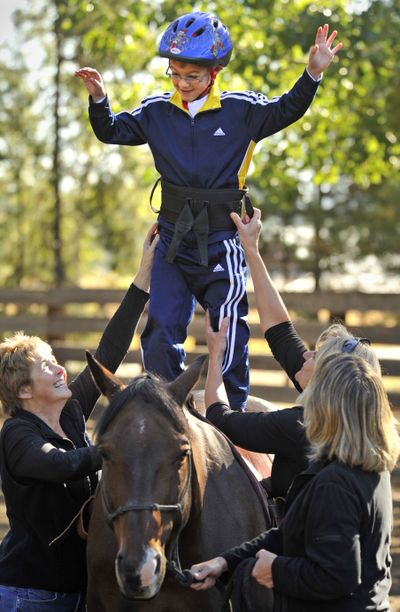Horses, specialists provide unique therapy in Deer Park

Arms outstretched like an airplane, Trey Henning, 6, beamed as he rode around the paddock. He sat astride Monte, a beautiful brown American quarter horse, looking like he’d been born to ride.
As Monte began to trot, Trey tipped his head back in bliss, savoring the movement and the September sunshine.
Trey has cerebral palsy. “He’s typically timid about things like riding a bike,” said his mother, Molly Henning. “He can’t catch himself well if he falls. He’s got decreased fine and gross motor skills on his right side.”
She’d brought Trey to this paddock near Deer Park to work with his physical therapist, Robyn Moug, director of clinical management for Rehab Without Walls in Spokane.
Moug is a clinical specialist in hippotherapy. This unique therapy pairs specially trained horses with patients, to increase hip and pelvic range of motion, strengthen the trunk, and provide valuable, effective sensory integration, among other benefits.
In short, Moug said, “This is not a riding lesson. Hippotherapy offers a way to deliver a multidimensional treatment session.”
Every aspect of Trey’s time with Moug and the horses is therapeutic. He started his session by grooming Moug’s two miniature horses. Working the brush through the horses’ long manes helps his fine motor skills.
When it was time to mount Monte, Moug had Trey take side steps to the horse. Once astride, he adjusted his body to the rhythm of Monte’s gait. He stretched his arms above his head as he rode, an exercise that is fun for him and an important way to improve his balance.
Henning has been thrilled with her son’s progress. “After he’s been on the horse he loosens up,” she said. “He’s able to have a much more even gait. This has made a huge difference for him.”
Part of that difference is simple motivation. Trey loves the horses and looks forward to his sessions.
“Hippotherapy offers tremendous motivation for children and many adults,” said Moug, who’s also worked with brain-injured soldiers. “The freedom of movement that they experience is the gift that most of us take for granted as we move throughout our day. It’s fun as it delivers its powerful package of treatment.”
His parents watched while Moug and her assistant helped Trey stand atop Monte. Well-trained horse handlers called side-walkers are an integral part of each session.
Trey grinned while he took his carefully assisted daredevil ride around the ring. “This is his favorite thing!” Henning said. “He is a 6-year-old boy, after all.”
As Trey helped lead Monte out of the ring, Moug said, “The gift of the horse is that Trey can achieve those positions on the horse and translate that into everyday life.”
Though hippotherapy has been widely embraced and promoted throughout Europe, Moug said the therapy hasn’t been as accepted in the U.S., and finding funding for these programs is difficult. “When I first started talking about hippotherapy, people thought I was crazy,” she said. “It’s an ongoing battle to have it recognized as very effective treatment. Most insurance companies will not cover this therapy because it’s classified as experimental. It’s a huge frustration as a therapist and for these families, too.”
Those who doubt hippotherapy’s benefits might do well to watch Moug and the horses work their magic on 10-year-old Ryan Sonneborn.
Sensory integration issues make the transition from one activity to another difficult. Ryan steadfastly refused to grab his walker and moved toward Toby, a Norwegian Fjord owned by Robin Pearson, the main horse handler for the program.
Moug coaxed him into movement by softly singing “Row, Row, Row Your Boat” while walking him toward Toby.
His mom, Ginger Sonneborn, explained, “Ryan was diagnosed with chronic lung disease and struggled to breathe for the first three years of his life. He was on a ventilator until he was 5.”
Consequently, he missed all of his developmental milestones. He didn’t eat solid food until 4 and didn’t begin to crawl until 5.
Ryan doesn’t speak, but still manages to make his feelings and opinions known through guttural sounds and sign language. “He’s been a miracle,” Sonneborn said. “He has the happiest heart.”
When finally atop Toby, Ryan still didn’t seem too pleased until his first slow circle around the ring. Suddenly, his agitated movements stopped – his tense body relaxed and a huge grin split his face, as he lifted his head toward the sun.
Sonneborn was thrilled. “Stimulus is overwhelming and being outdoors is difficult for him, but on Toby he actually looks around at the trees and notices his environment.”
As they circled the ring, Ryan engaged Moug in a game of peek-a-boo, grabbing her hands and putting them over his face repeatedly.
Moug positioned Ryan so he faced backward on the horse and after awhile Toby’s gait so soothed Ryan that he laid his head on the horse’s broad back and closed his eyes.
Part of the reason he’s so relaxed is that he’s simply worn out. Both Ryan’s body and mind have been worked hard in his hourlong session. Moug said, “This is hardcore therapy and so effective.”
For Sonneborn, the long drive from her South Hill home to Deer Park is more than worth it. “The horse therapy gives him so much happiness that he even wants to kiss his 11-year-old brother,” she said. “For the next 24 hours Ryan loves life. The world is opening up for him.”